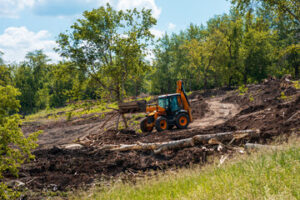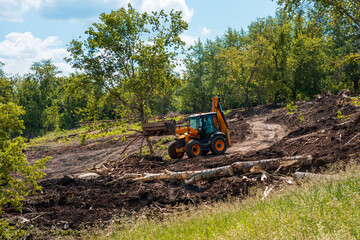Land Clearing Salado TX is the process of removing trees, shrubs, undergrowth, and other vegetation from land. This is done to prepare the land for its intended use. It also helps prevent fire hazards and improves safety on property.
The process involves assessing the site and developing a detailed plan to manage costs. It also requires securing any necessary permits and complying with local laws.
The cost of clearing land can vary based on the type and density of vegetation, grading requirements, and other factors. Taking the time to assess the specific needs of your site will help you plan for these expenses and avoid unexpected costs. It is also important to be aware of any additional fees that may be associated with your project, such as permit fees and environmental impact assessments. This information can be helpful in minimizing expenses and ensuring that your project is on schedule.
One of the most significant determinants of land clearing costs is the size of the area to be cleared. Larger areas require more labor and equipment to clear, which drives up costs. The condition of the land also plays a role in costs, as rocky or swampy terrain requires specialized equipment and extra labor to overcome, increasing the overall cost of the project. Additionally, local regulations may require specialized methods of disposal, which can increase expenses.
Aside from the cost of removing and disposing of debris, other costs can include clearing permits, hiring skilled workers, and paying for fuel. These expenses can add up quickly and should be considered in your budget. In addition, if the clearing process is conducted around existing structures or utilities, unforeseen expenses may be incurred to ensure safety and compliance with regulatory requirements.
It is important to understand the scope of your land clearing project before committing to it, as this will help you determine what services and equipment are necessary. For instance, light clearing prepares sites for concrete slab construction, requiring minimal obstruction removal and cost-effective terrain leveling with fill dirt. In contrast, dense clearing requires specialized equipment and expertise to remove tree stumps, branches, and other debris.
The initial stage of land clearing involves cutting down trees and removing any other vegetation that is blocking the area. The process can be done manually or with heavy machinery such as bulldozers and excavators. The remaining debris is then disposed of in a safe and environmentally responsible manner. If the land clearing process is carried out properly, erosion can be prevented and the soil can be reshaped for optimal drainage.
Techniques
The use of land clearing techniques is an important consideration for any construction project. Using the right methods can help reduce environmental impact and maximize efficiency. For example, proper soil preparation and erosion control during clearing can minimize the risk of soil loss. Considering ongoing maintenance requirements is also essential for long-term functionality and sustainability of the cleared area.
The best way to choose a clearing method depends on the size of the site and the type of vegetation present. For small properties, a hand clearing technique may be more appropriate than a mechanical one. In addition, a detailed plan can ensure that the land clearing process runs smoothly and efficiently.
For larger properties, mechanical clearing is a common option. Using heavy machinery like bulldozers, excavators, and skid steers can clear large areas of land quickly. Often, these machines remove stumps and grind them into mulch to prevent regrowth. They are also great for removing larger trees and debris. However, this method can be expensive, especially if the land clearing is done on a large scale.
Another alternative is forestry mulching, which reduces the need for heavy equipment and helps protect the environment by retaining moisture and reducing soil disturbance. It also improves the site’s ecosystem by promoting new plant growth. This sustainable approach is more environmentally friendly than traditional clear cutting and can be used for a variety of purposes, including land development, landscaping, and agriculture.
Lastly, controlled burning is a good option for land clearing, as it returns nutrients to the soil by recycling nutrients that are released into the air during combustion. It can also be effective for pest management and weed control. However, it is important to consult with a professional before using this method.
When choosing a clearing method, it’s crucial to consider the impact on nearby water sources and surrounding vegetation. Incorrectly clearing a site can lead to soil erosion, which can be harmful to local wildlife and plants. A recent case in which a developer did not consider erosion control during land clearing resulted in significant damage to surrounding habitats and a lack of water resources.
Environmental impact
Regardless of the intended purpose, any Land Clearing activities should be conducted responsibly to avoid harming the environment. This includes avoiding the removal of valuable species and habitats. In addition, it is important to keep an eye on the weather conditions and soil characteristics to minimize the impact of clearing activities. It is also important to consider the impact of the debris that will be generated during the clearing process, and to find ways to reduce its negative effects.
One of the biggest impacts of Land Clearing is that it can lead to soil erosion. Without the binding roots of vegetation, the soil is more likely to be washed away during rainstorms or by wind. This can damage the fertility of the soil, as well as pollute rivers and streams. To combat this, sustainable Land Clearing practices use contour planting and retention ponds to promote water infiltration and reduce erosion. In addition, they repurpose cleared biomass as mulch or biofuel, reducing deforestation rates and its associated environmental impacts.
Another issue is that clearing can cause the loss of habitats for native animals and plants. It can also disrupt the flow of water in natural ecosystems, which can contribute to flooding and droughts. To address this, sustainable Land Clearing practices prioritize the preservation of a healthy environment and work closely with local communities to ensure that development projects are carried out in a way that does not disturb wildlife and nature.
The first step in the Land Clearing process is a thorough assessment of the site to determine the scope of the project and any environmental issues that need to be addressed. This may involve conducting surveys, analyzing soil conditions, and identifying protected or sensitive areas that require special consideration. In addition, it is important to identify potential hazards such as underground pipes or cables, which can be impacted by the clearing process.
In addition, sustainable Land Clearing practices use the latest technology to improve efficiency and reduce labor costs. This can help to increase productivity and ensure that the process is completed safely and on time. Finally, they use environmentally friendly equipment and techniques to limit the amount of dust and noise produced during the operation.
Permits
If you are planning to clear land on your property, you will need a permit from the city or village. Permits are required to protect the environment and ensure that your work is done properly. They also help to prevent flooding and excessive runoff. In addition, they may stipulate that certain areas must remain untouched to preserve sensitive ecosystems like wetlands or streams. Permits may also regulate grading to control erosion. They may require that you submit a detailed site plan and an environmental impact assessment, as well as a fee for the permit.
The process of clearing land can be complex, and it’s important to take the time to find a professional service provider who is knowledgeable in best practices. A good service provider will be transparent, communicative, and committed to delivering high-quality results. It will also provide a contract that clearly outlines the scope of the project, timeline, and costs. You should carefully review the contract before signing it.
There are several reasons why you might need to clear land, including farming or livestock grazing, fire mitigation, and landscape improvement. However, clearing can cause environmental damage if it is not carried out correctly. Incorrect methods or improper equipment can lead to soil erosion, habitat destruction, and biodiversity loss. Erosion controls such as silt fences are essential to prevent these problems.
When clearing land, you should also consider the impact on nearby wildlife species. Some species rely on local vegetation for food, shelter, and water sources. If these plants are removed, the animals will have to travel farther for these resources, which can cause injuries or even death. In addition, removing too much vegetation can disrupt the water flow and increase flood risk.
If you’re not careful, a land clearing project can lead to environmental harm and lawsuits. The local government enforces strict rules to prevent damage to sensitive ecosystems and ensure public safety. These include protection of native vegetation, tree preservation ordinances, and wetland and coastal zone regulations. Permits are required for residential land clearing on properties over a certain acreage and for projects near wetlands or other environmental resources.

